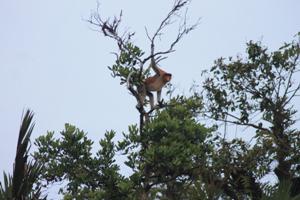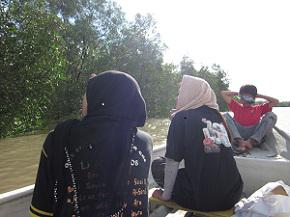Ho Licia
This project was aim to provide empirical genetic data within and among N. larvatus populations in Sarawak, and to elucidate their gene flow, genetic structure.

Probosics monkey in Samunsam Wildlife Sanctuary.
Nasalis larvatus, the Proboscis Monkey is an endemic species that only can be found in the island of Borneo. They are highly restricted in lowland coastal rainforest, such as mangrove and peat swamp forest with many of which flooded by tides. N. larvatus are now been classified as Endangered under IUCN Red List of Threatened Species and listed under Appendix I of CITES. In Sarawak, N. larvatus are classified as Totally Protected under Wild Life Protection Ordinance 1998.

Boat Survey.
The population trend of N. larvatus is now suffering extensive reduction, mainly due through habitat destruction, such as excessive mangrove forest logging and land conversion to agricultures or oil-palm plantation. Fragmentation and isolation of small population will possibly impact on the population genetics or genetic diversity of N. larvatus. In past, studies on primates have mainly focused on their taxonomic status, living behaviours and diets, with rather fewer studies focusing on their population genetic structure. To date, the genetic information on N. larvatus is very scarce and not well represented, especially in Sarawak. Therefore, genetic study on N. larvatus populations is vital. Thus, this project was aimed to investigate the genetic diversity and to assess the genetic structuring of N. larvatus populations in Sarawak.
This project would focus on wild populations of N. larvatus in Sarawak region. Non-invasive sampling would apply by collecting fecal samples. Boat survey planned to be conducted in two separate sessions for each sampling sites: the early morning 0630 and the late afternoon 1400 or early evening 1600. Two observers will be assigned in searching both the riverside vegetation as the boat passed by. Once a group of N. larvatus was encountered will be observe in a distance, and slowly approach to the area once the N. larvatus had moved away. Fecal samples will usually search underneath of the feeding trees. Information such as GPS reading will be recorded. Genomic DNA will be extracted and amplified by using mtDNA and nuclear gene. Subsequently, sequence data will be analyzed using software; DNASP 5.1 and Arlequin 3.5.
We hope that the genetic data obtained through this project could provide a better understanding on the genetic fitness of N. larvatus and also to provide basic guideline in long-term strategies of conservation management plans for this species.